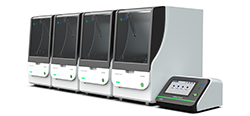-
REAGENT SERVICES
Hot!
-
Most Popular Services
-
Molecular Biology
-
Recombinant Antibody/Protein
-
Reagent Antibody
-
CRISPR Gene Editing
-
DNA Mutant Library
-
IVT RNA and LNP Formulations
-
Oligo Synthesis
-
Peptides
-
Cell Engineering
-
- Gene Synthesis FLASH Gene
- GenBrick™ Up to 200kb
- Gene Fragments Up to 3kb now
- Plasmid DNA Preparation Upgraded
- Cloning and Subcloning
- ORF cDNA Clones
- mRNA Plasmid Solutions New!
- Cell free mRNA Template New!
- AAV Plasmid Solutions New!
- Mutagenesis
- GenCircle™ Double-Stranded DNA New!
- GenSmart™ Online Tools
-
-
PRODUCTS
-
Most Popular Reagents
-
 Instruments
Instruments
-
Antibodies
-
ELISA Kits
-
Protein Electrophoresis and Blotting
-
Protein and Antibody Purification
-
Recombinant Proteins
-
Molecular Biology
-
Stable Cell Lines
-
Cell Isolation and Activation
-
 IVD Raw Materials
IVD Raw Materials
-
 Therapy Applications
Therapy Applications
-
Resources
-
- All Instruments
- Automated Protein and Antibody Purification SystemNew!
- Automated Plasmid MaxiprepHot!
- Automated Plasmid/Protein/Antibody Mini-scale Purification
- eBlot™ Protein Transfer System
- eStain™ Protein Staining System
- eZwest™ Lite Automated Western Blotting Device
- CytoSinct™ 1000 Cell Isolation Instrument
-
- Pharmacokinetics and Immunogenicity ELISA Kits
- Viral Titration QC ELISA Kits
- -- Lentivirus Titer p24 ELISA KitHot!
- -- MuLV Titer p30 ELISA KitNew!
- -- AAV2 and AAVX Titer Capsid ELISA Kits
- Residual Detection ELISA Kits
- -- T7 RNA Polymerase ELISA KitNew!
- -- BSA ELISA Kit, 2G
- -- Cas9 ELISA KitHot!
- -- Protein A ELISA KitHot!
- -- His tagged protein detection & purification
- dsRNA ELISA Kit
- Endonuclease ELISA Kit
- COVID-19 Detection cPass™ Technology Kits
-
- Automated Maxi-Plasmid PurificationHot!
- Automated Mini-Plasmid PurificationNew!
- PCR Reagents
- S.marcescens Nuclease Benz-Neburase™
- DNA Assembly GenBuilder™
- Cas9 / Cas12a / Cas13a Nucleases
- Base and Prime Editing Nucleases
- GMP Cas9 Nucleases
- CRISPR sgRNA Synthesis
- HDR Knock-in Template
- CRISPR Gene Editing Kits and Antibodies
-
![AmMag™ Quatro Automated Plasmid Purification]() AmMag™ Quatro automated plasmid purification
AmMag™ Quatro automated plasmid purification
-
![Anti-Camelid VHH]() MonoRab™ Anti-VHH Antibodies
MonoRab™ Anti-VHH Antibodies
-
![ELISA Kits]() ELISA Kits
ELISA Kits
-
![Precast Gels]() SurePAGE™ Precast Gels
SurePAGE™ Precast Gels
-
![Quatro ProAb Automated Protein and Antibody Purification System]() AmMag™ Quatro ProAb Automated Protein and Antibody Purification System
AmMag™ Quatro ProAb Automated Protein and Antibody Purification System
-
![Target Proteins]() Target Proteins
Target Proteins
-
![AmMag™ Quatro Automated Plasmid Purification]() AmMag™ Quatro automated plasmid purification
AmMag™ Quatro automated plasmid purification
-
![Stable Cell Lines]() Stable Cell Lines
Stable Cell Lines
-
![Cell Isolation and Activation]() Cell Isolation and Activation
Cell Isolation and Activation
-
 IVD Raw Materials
IVD Raw Materials
-
![Quick
Order]() Quick Order
Quick Order
-
![Quick
Order]() Quick Order
Quick Order
- APPLICATIONS
- RESOURCES
- ABOUT US
- SIGN IN My Account SIGN OUT
- REGISTER

![Custom Monoclonal Antibody Development Services Custom Monoclonal Antibody Development Services]()
Custom Monoclonal Antibody Development Services
Get the most antibody clones for your research application!
Resources » Learning Center » Research Digest » Production of Novel Monoclonal Antibodies Against the SERINC5 HIV-1 Restriction Factor
Production of Novel Monoclonal Antibodies Against the SERINC5 HIV-1 Restriction Factor
Summary
In this article, Molnar et al. developed a series of novel monoclonal antibodies against the multi-pass transmembrane protein SERINC5. Later, they demonstrated that these SERINC5 mAbs can be used to detect endogenously expressed SERINC5 protein in various cell lines and furtherly showed some of the antibodies could detect SERINC5 that is presented in HIV-1 viral stocks. Monoclonal antibodies obtained in this work could provide tools to study the functions and mechanisms of SERINC5 and potentially be engineered to serve as therapeutic tools.
Background
The serine incorporator (SERINC) protein family has five members that localize to cell membranes. Previous studies have shown that SERINC3 and more potently, SERINC5, can effectively restrict HIV-1 infection. However, the detection of endogenous SERINC proteins in cells has been limited so far as to the lack of suitable antibodies, thus posed a challenge for the study of the proteins. To solve this problem, Molnar et al. utilized a DNA-prime/peptide boost immunization regimen in mice to produce monoclonal antibodies (mAbs) directed against both intracellular and extracellular loops of SERINC5.
Experiment
To obtain mAbs directed against SERINC5, the researchers use a prime-boost immunization strategy in mice with a full-length SERINC5.1 DNA prime and peptide boosting immunogens.
Immunogen design
Three SERINC5 peptides were selected as target epitopes in two extracellular domains (ECL1 and ECL4) and one intracellular epitope (ICL4), based on sequence, antigenicity, surface and hydrophilicity scores predicted by OptimunAntigen™. Keyhole limpet hemocyanin (KLH) was conjugated with the ECL4 and ICL4 peptides to improve immunogenicity.
Animal immunizations
BALB/c mice were immunized intradermally with codon-optimized SERINC5.1 DNA and then boosted with KLH-peptide during a 22-week immunization schedule. Mouse serum reactivity was measured by peptide ELISA. Notably, a HEK293 cell line stably transduced with tagged SERINC5.1 gene were constructed to test the specificity of the mouse sera and subsequently the mAbs. Finally based on the assessment results of peptide ELISA, whole-cell ELISA (WCE) and Western blots (WB), a group of mice were selected for cell fusion.
Hybridoma cell line fusion and sub-cloning
Hybridoma cell supernatants for reactivity to the relevant peptides were screened by peptide ELISA to select reactive clones. Next, the hybridoma supernatants and subclones were evaluated according the screening strategy using peptide ELISA, WCE and WB. Based on the analysis results, four anti- SERINC5 hybridoma cell lines were selected for mAb production. At last, these hybridomas were scaled up to produce mAbs.
Results
Four anti-SERINC5 mAbs- labeled 14C1-1, 18B6-1, 23E4-1, and 28E8-2 respectively were obtained through this prime-boost immunization strategy. The researchers then validated the specificity of the mAbs with WB analysis, and assessed the applicability for flow cytometry (FC) using the HEK293_S5.1 cell line. Through immunocytochemistry staining of HEK293_S5.1 cells and the mAbs were able to detect endogenous localization of SERINC5.1 at both the cell surface and within the cells. A virus capture assay using filtered virus stock suggest that the 14C1-1 and 23E4-1 mAbs recognize surface-exposed SERINC5 loops, and that the 28E8-2 mAb binds a more sequestered, internal loop on viral SERINC5.
"These antibodies will aid in the characterization of the functions and mechanisms of action of SERINC5 in different cell types." as the authors said.
Reference
-
Molnar, Sebastian, et al. "Novel monoclonal antibodies to the SERINC5 HIV-1 restriction factor detect endogenous and virion-associated SERINC5." MAbs. Vol. 12. No. 1. Taylor & Francis, 2020.
Related Services
Additional Resources

-





































